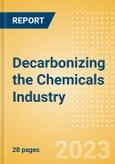Accounting for 14% of industrial emissions in 2021, the chemicals industry represents a key point of intervention for achieving net-zero targets but remains a sector whose emissions are among the hardest to abate. The chemical industry underpins much of the materiality of modern life, with its end-products spanning agricultural, construction, and consumer industries. Carbon emissions from the chemical industry can be broken down into direct energy demand and process emissions, both of which represent a challenge to decarbonization. As a result of these two emission sources, a combination of energy transition technologies and measures will need to be required to curb emissions from the sector. These include, hydrogen, CCUS, increasing process efficiency, and the use of biomass and waste as feedstock.
Key Highlights
- Almost two thirds of emissions from the chemicals industry come from energy use. Energy is used to heat and cool reactions, grind and mix compounds, and transport around the plants.
- In order to get on track with net zero emissions, ammonia needs to drastically reduce its petroleum dependency, going beyond the current policies set out. Upscaling of green hydrogen needs to be accelerated to decarbonize ammonia production.
- Methanol made up around half the primary chemical production in 2018 and is expected to see a demand increase of 17.56% from 2023-2030 due to rising demand from automotive and construction industries in developing economies
- Despite the ICCA claiming to support the Paris Climate agreement, the IEA considers the chemicals industry to be ‘not on track' for its 2030 checkpoint
- Global carbon capture capacity within the chemicals sector is forecast to see a 14.2% CAGR from 2020-2030, with groundbreaking projects becoming operational in the next few years increasing capacity.
Scope
- The chemical industry's current contribution to carbon emissions
- Key chemicals for decarbonization
- Focus technologies for decarbonizing the chemical sector
- Carbon Capture, Utilization, and Storage (CCUS)
- Hydrogen
- Process efficiency
- Biomass and waste as feedstocks
Reasons to Buy
- Obtain the most up to date information on recent developments and policies effecting the chemical industry's energy transition.
- Identify key energy transition technologies for the decarbonization of the chemical industry
- Obtain market insight into current rates of technology adoption and the factors that will shape the sector's decarbonization.
- Identify the companies most active companies across CCUS, hydrogen, process efficiency, and feedstocks derived from biomass and waste within the chemicals sector.
Table of Contents
- Executive Summary
- Chemicals’ carbon emissions
- Chemicals industry’s contribution to climate change
- Ammonia’s contribution to carbon emissions
- Methanol’s contribution to carbon emissions
- Chemicals industry’s progress towards net-zero
- Introduction to decarbonization technologies
- Four key decarbonisation technologies for chemicals
- Technologies by decarbonization potential and stage
- Macroeconomic challenges that will pose a barrier to decarbonization
- Carbon Capture, Utilisation, and Storage (CCUS)
- Forecast CCUS capacity in the chemicals industry
- Using captured carbon as feedstock
- Carbon negative chemicals
- Hydrogen
- Global hydrogen capacity
- Case studies from the chemicals industry
- Process Efficiency
- Energy use in the chemicals industry
- Process efficiency case studies
- Biomass and Waste as Feedstocks
- Biomass
- Recycling waste to chemical products
- Key takeaways
- Contact the Publisher
- Assessing decarbonization technologies: advantages and disadvantages
- Key takeaways
- Direction emissions from Industry, 2021
- Supply and demand of base chemicals, 2000-2030
- Petrochemical capacity of top 10 commodities, 2022
- Emissions from ammonia under different climate projection scenarios, 2020 - 2050
- Petrochemical capacity of top 10 commodities, 2022
- Comparison of CO2 emissions intensity from primary chemical production in 2022 and 2030 in a net zero scenario
- Direct emissions intensity of the chemical industry in the net zero scenario
- The top four energy transition technologies for the chemicals industry
- Chemicals sector decarbonization challenges
- Carbon capture capacity from chemicals manufacturing, 2020 - 2030
- Chemical industry hydrogen pipeline estimated capacity share before 2030
- Global hydrogen capacity, 2021 - 2030
- Energy consumption in chemicals under NZE scenario
- Total renewable fuel production capacity, 2023 - 2030
Companies Mentioned (Partial List)
A selection of companies mentioned in this report includes, but is not limited to:
- Carbon Recycling International
- HIF Global
- LanzaTech Inc
- ArcelorMittal SA
- Made of Air
- H&M Group
- Econic Technologies Ltd
- Monument Chemicals Inc
- ABB Group
- Skovgaard Energy A/S
- Topsoe A/S
- Vestas Wind Systems AS
- Fortescue Future Industries Pty Ltd
- Plug Power Inc
- Sasol Ltd
- Svevind Energy Group
- Korea Electric Power Corporation
- CWP Global
- HeatMatrix Group
- BASF Corporation
- OCI Global
- SunGas Renewables Inc
- Moller-Maersk AS
- Enerkem Inc
- Eastman Chemical Company








